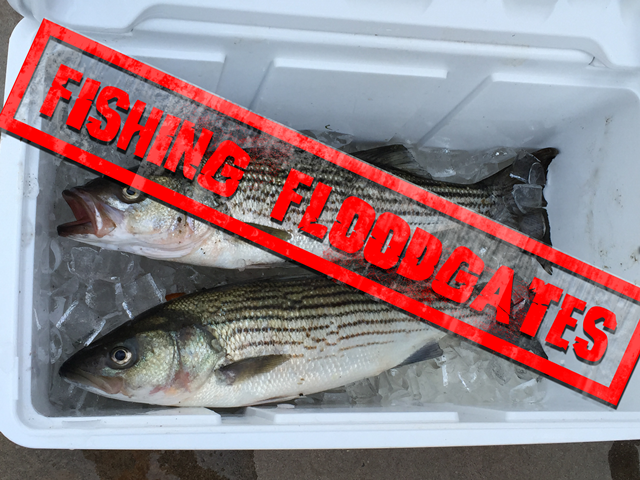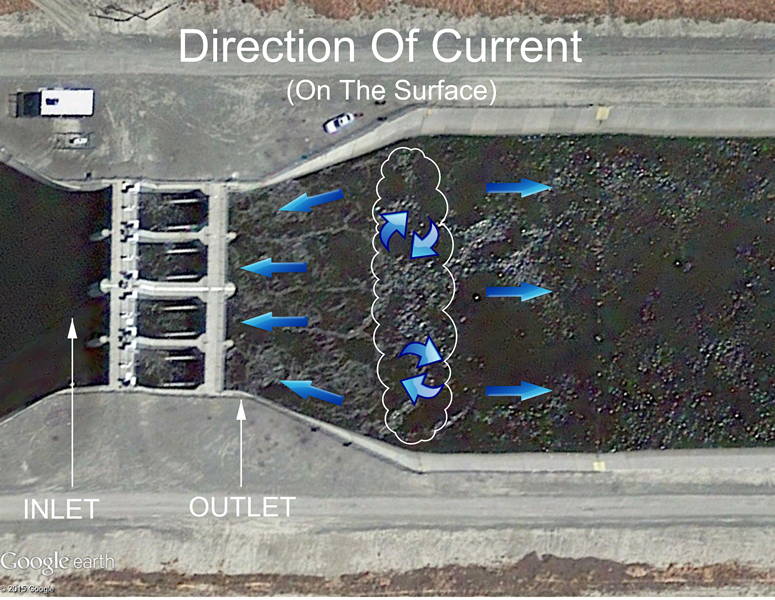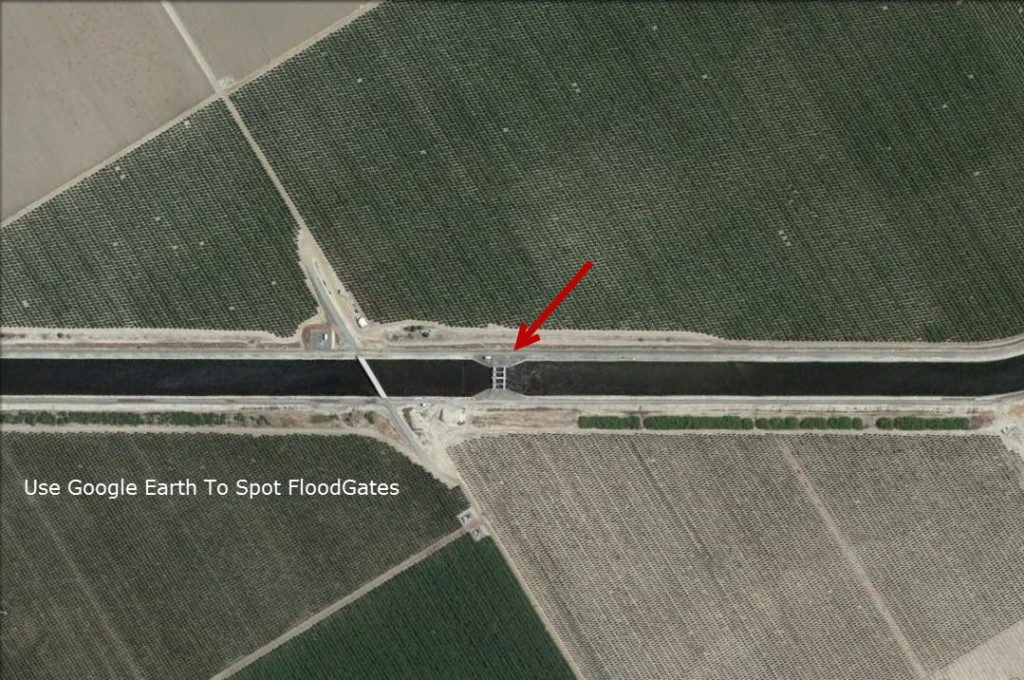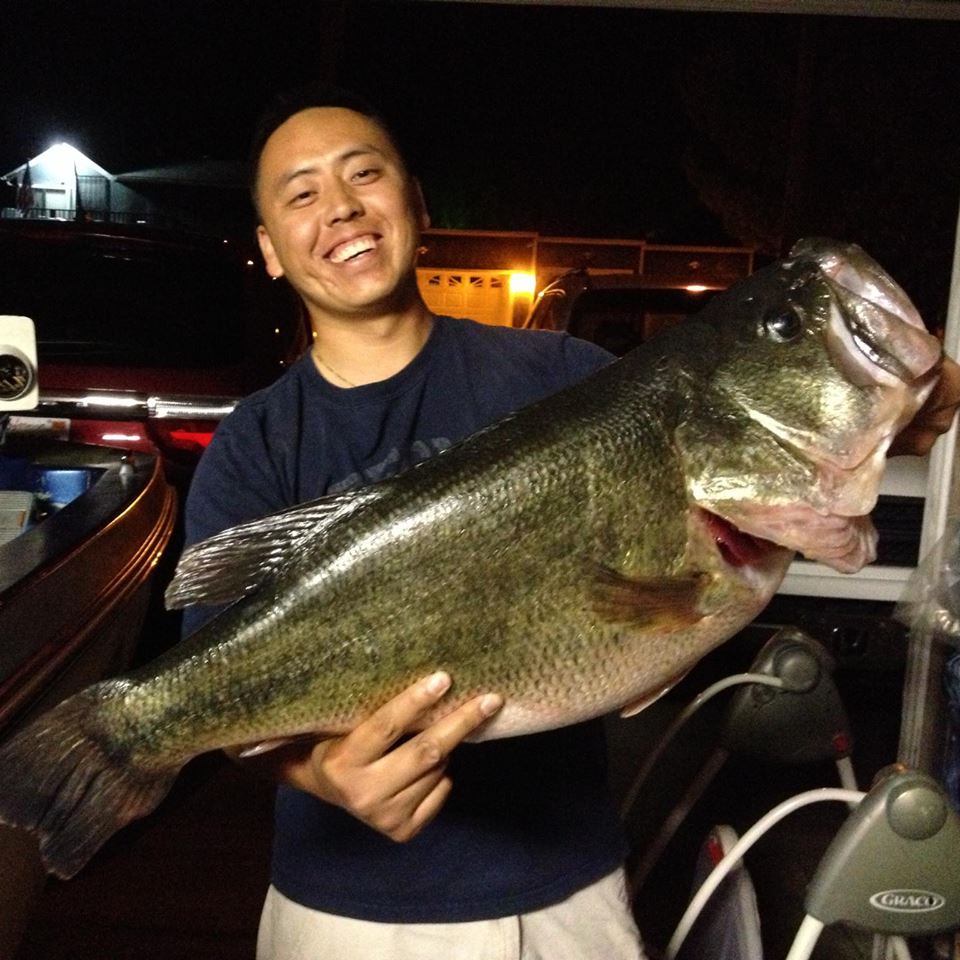
Striper Fishing At The California Aqueduct Near FloodGates
Edit: Sorry for the confusion. These are called check gates not “flood gates.”
If you’re still trying to figure out where to catch striped bass at the California Aqueduct, here’s a great place to start: Flood Gates. So what are flood gates and where can I find them?
The aqueduct is a long expanse of canal that transfers water from the rain rich mountains of Northern California to the Agricultural rich Central Valley. Then ultimately to Southern California.
To control the flow of water along the aqueduct, flood gates were incorporated into the canal system. They are huge curved metal gates that stop or allow the flow of water through the California Aqueduct water system.
Flood gates are located all along the California Aqueduct. Each gate is about 10-15 miles apart.
The best way to locate a flood gate in your area is to use Google Earth. Below is an image of one viewed from above.
So what makes these locations so popular?
Well for one, predatory fish are naturally opportunistic feeders. This means they’ll do their best to find an easy meal.
Bait fish get pushed under these huge gates. The turbulent water disorients them right into the stripers waiting in ambush.
Imagine a wind tunnel. And being blown through it are five and ten dollar bills. I bet that’d be a popular place to hangout right? That’s what the entrance of a flood gate is to a striper.
Keep In Mind
It is extremely dangerous to fish on or walk along the canal wall near flood gates. The current here is unforgiving.
Be very cautious when fishing these areas. Especially when trying to land your fish.
I should point out, there are designated trash can bins that are maintained by the state. Anglers should clean up after themselves after fishing in the area.
In the recent years, there have been reports of authorities kicking anglers out because these locations have become too cumbersome to maintain. All it takes is one bad egg to ruin it for the rest of us. Let’s all do our part and keep these areas clean.
All flood gates are enclosed by a chain link fence. This is to prevent people from accidentally falling into these turbulent waters.
People sometimes cutout holes in the fence to access these waters. Please be aware that damaging state property is a fine of up to $1,000 or up to one year in prison or both.
Plus, if you are cited for trespassing inside the fenced off perimeter, the fine can be up to $1,000 or jail time as well.
Now you know.
Water Flow Direction
The diagram below shows the direction of the current on the surface. In the image, the water flow is from left to right. The flow near the surface reverses back into the flood gate slots after it emerges from the depths while most of the flow continues south.
Depending on the force of the flow, the water turbulence can make the direction of water flow very unpredictable. The typical direction of water flow is shown below.
Be aware, the blue arrows represent the direction of flow on the surface. Conditions underneath the surfaced are constantly changing therefore making it unpredictable.

How To Fish Flood Gates:
Knowing how the direction of flow is very helpful when fishing these areas. There’s no magic formula for catching these stripers so I’ll show you what’s worked for me.
In the videos below, I’m using jerkbaits such as SpeedLures or Duo Realis that dive 4-5 feet below the surface. On this particular day, the gates were about 75% open so there was a significant amount of water flowing through it.
While fishing this location, I’m simply popping the lure and slowly retrieving it back. The current is doing the work for me and the short pause is what’s enticing the stripers to strike.
I’m also moving around and trying different locations and angles to entice a fish to bite. Sometimes when you least expect it, a fish till take your lure as you can see in the video.
Using Flukes
A weightless fluke can do wonders even in fast moving waters. The key is to let it sink about 5-8 feet below the surface.
Once it’s near this depth, jerk it back like you would a jerkbait. Remember to pause to let the fluke sink again. Repeat this to the shore and stripers are sure to hammer it.
In the clip below, you’ll see that dead sticking (when you don’t do anything to the lure) can be quit effective too.
I had a minor birds nest and that allowed the fluke to sink even lower with the water current. When I finally jerked the bait back, a striper hammered it.
In the second part of the clip, I fish the fluke just under the surface. This presentation made the fluke look like it was darting away trying to escape from predatory fish.
Using Jerkbaits
Jerkbaits are great searching lures. On this trip, I let the current do most of the work. I was popping the lures (doing a quick pull) with my rod and retrieving it back. The majority of my hookups came when I popped the lure again after a short pause.
Morning and Evening Bite
In low light conditions, such as early morning or nearing the sunset hours, you typically want to use reaction based lures. These lures can be jerkbaits, top water lures or flukes.
Stripers traditionally hunt and are more active during these hours.
Start out with a faster retrieve pattern. Jerk the lure rapidly, create a lot of noise, move it quickly through the water.
You want to catch the hungry and active fish first. These fish will be actively searching for food and when all that commotion and noise attracts them, they’ll hone in on it and hammer that lure.
Sometimes you’ll witness a plethora of stripers chasing your lure right up to the canal wall. There are times when they’ll take the lure just moments after it hits the water surface.
Whatever the reason, let the stripers tell you what they want.
Sometimes, you’ll notice a frenzy of bites and hookups your first few casts. I mean every cast is a bite or fish on. Then as if on cue, it shuts off. When that happens, it’s quite normal actually.
Stripers are notorious for this kind of bite. What you need to do is move on.
Move up or down to the next gate and repeat the same pattern that was working before. More likely than not, they’ll be hitting on the same pattern at the next gate.
If you do decide to stay and fish the area when you’ve noticed the bite has shutoff, slow down your retrieve and fish deeper.
Fishing lower in the water column works great. This is especially true in the later morning hours. When the sun has risen over a certain height, you’ll notice sometimes the bite just seems to shut off completely.
A slower and smaller profile lure will have a better chance at enticing them to bite. You’ll need to target them deeper in the water column.
Flow vs. No Flow
I’ve had success fishing flood gates with and without water flowing. Here’s what’s worked for me in these conditions.
Flow Conditions
The current changes from day to day, hour to hour. It’s very unpredictable. The flood gates can close or open as you are fishing. One of the most exiting times to fish is when the gates open up after having no water flowing. It goes from calm to turbulent in seconds.
This is the time to throw your reaction lures. A SpeedLure would work great here. Focus on the canal walls as well.
All the baitfish in the area will find the least amount of current. These locations are typically along the canal walls.
When the water is flowing, you want to let the current do most of the work. Stripers maybe cruising in the turbulent waters for an easy meal.
Baitfish often get sucked under these giant flood gates and the fast moving current often disorients them when they exit out on the other side. This creates a perfect opportunity for predatory fish to pick off these fish.
So, a jerkbait running through the area would be like a dinner bell calling these fish from all around. Actively searching stripers will hone in on your lure and hammer it.
No Flow conditions
In no flow conditions, just like in flowing conditions, you want to see if there are active fish first.
Cast out a jerkbait and start off with a fast retrieve and maybe an occasional pause. It’s a good idea to keep track of where your lure is.
What you want to do is scan behind the lure and see if there are stripers swiping at it.
If you notice this, repeat the retrieve a few more times. If you don’t hookup into anything, switch things up. Most of the time, subtle changes in the lures movement is all it takes to draw a strike.
If you don’t see any chasers, it doesn’t mean they’re not there. In fact, there could be a number of reasons they are not chasing your lure.
If after a few attempts you don’t get a bite on your reaction lures, try something else. A deeper diving lure or sinking lure to fish the lower water column is a must at this point.
I’m a big fan of the weightless fluke. In no flow conditions, this soft plastic can work wonders.
Combine it with a Gamagatzu offset hook in size 4 or 5. When it sinks, it will flutter from side to side. Let it fall about 5-8 feet under water, reel in the slack and jerk it once or twice and let it fall again. Then repeat.
You can try moving the fluke rather quickly like a darting baitfish thats trying to get away or fish it slowly like an injured fish. That’s what so good about using flukes. They are one of the most versatile baits out there.
Did This Post Pump You Up? I sure am! Open up Google Earth and find a flood gate nearest you. Remember to keep moving if you don’t see any results.
What other techniques, lures or tips would be just as effective here?
Let me know what you think below.
Thanks so much and be sure to subscribe to Fishaholics to get the latest posts delivered right to you!
Like what you read? Sign up for the newsletter below and get exclusive content that you cannot find here on the blog, as well as details about how I landed a monster: 14lb Largemouth bass. [mc4wp_form]


